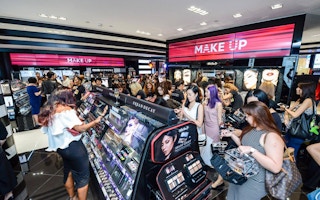Ten of the world’s biggest beauty and personal care companies have been found to be severely lacking in their efforts to curtail their environmental impact, despite making high-profile sustainability commitments.
To continue reading, subscribe to Eco‑Business.
There's something for everyone. We offer a range of subscription plans.
- Access our stories and receive our Insights Weekly newsletter with the free EB Member plan.
- Unlock unlimited access to our content and archive with EB Circle.
- Publish your content with EB Premium.
The Carbon Trust, a climate advisory firm, assessed the credibility of climate action taken by beauty and cosmetics giants L’Oréal, Unilever, Procter & Gamble, Estée Lauder, Shiseido, Beiersdorf, Moët Hennessey Louis Vuitton, Kao, Coty and Johnson & Johnson using a tool that analyses publicly available sustainability and greenhouse gas emissions (GHG) reports.
The report found that the 10 companies’ main emissions sources were the raw materials used in their products and packaging as well as their customers’ consumption of water and energy when using the products, also known as Scope 3 emissions.
The raw materials included fossil fuel-based synthetic ingredients as well as extracted minerals, while the paper used in packaging comes with deforestation risk. According to the report, these factors combined make up 30 to 50 per cent of the assessed companies’ emissions.
Many of these companies’ products such as shampoo and shaving foam require rinsing off, which generates heavy indirect emissions as the energy used to heat water for bathing is often derived from fossil fuels.
The report highlighted that the assessed companies’ net zero transition plans were “either non-existent or lacked details on how deep emissions reductions would be delivered.”
Some of the climate targets set by these companies include LVMH pledging to achieve a 55 per cent reduction in Scope 3 emissions by 2030, and Shiseido aiming to achieve carbon neutral operations by 2026 for its Scope 1 and 2 emissions. L’Oreal has targeted net-zero emissions by 2050 and Johnson & Johnson by 2045.
However, the report noted that even the most comprehensive of the firms’ climate action plans showed limited willingness to transform their business models to shrink their emissions footprint. Rather, the companies were more likely to address their operational emissions, but have not addressed their much bigger Scope 3 emissions.
Although three of the 10 companies acknowledged that consumer use contributed to their emissions, only two of them outlined targets to reduce such emissions.
The report stressed that third-party verification of net-zero targets was required to ensure that a company achieves its climate goals within the pledged timeframes. However, none of the companies had an externally validated net zero target.
Net zero goals can be externally validated by organisations such as the United Nations and World Wide Fund for Nature (WWF)-backed Scienced-Based Targets initiative (SBTi) to ensure that their emissions reduction plans are in line with global climate targets.
Without science-based targets, companies are not aligned with the Paris Agreement goal of keeping global warming under 1.5°C. All ten of the assessed companies had emissions reductions targets to meet by 2030, but two were in line with 2°C of warming goal rather than 1.5°C.
The report noted a high dependence on carbon offsets among the studied climate commitments. Only half of the companies assessed demonstrated awareness of the need to reduce emissions before buying carbon offsets. Only three published clear statements that only “carefully selected” offsets would be used as an addition to emissions reductions.
Eco-Business reached out to the assessed companies for comment. Only Japanese cosmetics firm Kao Corporation responded.
When asked about the report’s claim that its net zero targets have not been externally validated, a company representative said that the SBTi has validated the company’s 2030 climate targets with regards to scope 1 and 2 emissions, as well as lifecycle carbon dioxide emissions.
The representative acknowledged that consumer product use and raw material procurement were its biggest emissions sources.
She also said that the environmental impact of consumer use is being addressed through product innovation. An example is its development of detergents that require smaller amounts of water to clean and rinse.
The Carbon Trust’s analysis comes at a time of high consumer demand for eco-friendly products. Two-thirds of respondents to a survey by McKinsey said that they consider sustainability when they make purchases.










